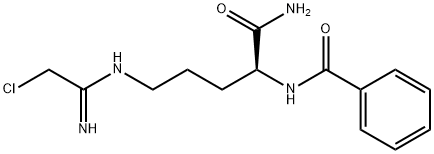913723-61-2
 913723-61-2 結構式
913723-61-2 結構式
基本信息
N-[(1S)-1-(氨基羰基)-4 -[(2 - 氯-1-亞氨基乙基氨基]丁基]-苯甲酰胺
N-alpha-Benzoyl-N5-(2-chloro-1-iminoethyl)-1-ornithine amide
N-[(1S)-1-(Aminocarbonyl)-4-[(2-chloro-1-iminoethyl)amino]butyl]benzamide
Benzamide, N-[(1S)-1-(aminocarbonyl)-4-[(2-chloro-1-iminoethyl)amino]butyl]-
N-[(1S)-1-(Aminocarbonyl)-4-[(2-chloro-1-iminoethyl)amino]butyl]-benzamideN-
常見問題列表
IC50: 0.8 μM (PAD1), 5.9 μM (PAD4), 6.2 μM (PAD3).
Cl-amidine is a bioavailable haloacetamidine-based compound that inhibits all the active PAD isozymes with near equal potency (k
inact
/K
I
=13,000 M
-1
?min-1 for PAD4).
Cl-amidine (0, 5, 10, 15, 20, 25, 50 μg/mL, 24 hours) induces apoptosis in TK6 lymphoblastoid cells and HT29 colon cancer cells in a dose-dependent manner. Interestingly, the colon cancer cell line (HT29) is relatively resistant to apoptosis caused by Cl-amidine.
Cl-amidine irreversibly inactivates PADs by covalently modifying an active site cysteine that is important for its catalytic activity.
Apoptosis Analysis.
| Cell Line: | TK6 lymphoblastoid cells and HT29 colon cancer cells. |
| Concentration: | 0, 5, 10, 15, 20, 25, 50 μg/mL. |
| Incubation Time: | 24 h. |
| Result: | Induced apoptosis dose-dependently. |
Cl-amidine (75 mg/kg, ip once daily) suppresses and treats DSS-induced colitis in mice.
Cl-amidine (5, 25, 75 mg/kg, oral gavage, once daily) leads to significant reductions in the histology scores dose-dependently.
| Animal Model: | C57BL/6 mice (8-12 wk old, DSS mouse model of colitis). |
| Dosage: | 75 mg/kg. |
| Administration: | IP once daily. |
| Result: | Suppressed PAD activity, protein citrullination, and PAD levels in the colon in vivo. |
| Animal Model: | C57BL/6 mice (8-12 wk old, DSS mouse model of colitis). |
| Dosage: | 5, 25, 75 mg/kg. |
| Administration: | Oral gavage once daily. |
| Result: | Led to significant reductions in the histology scores. |
